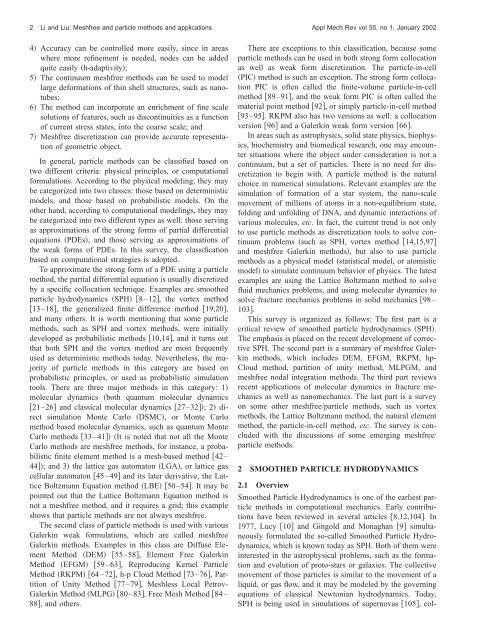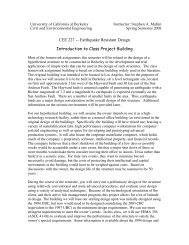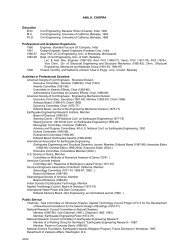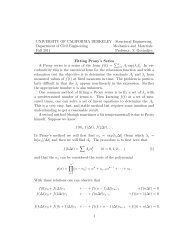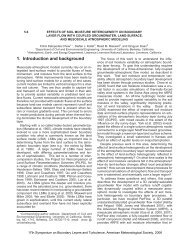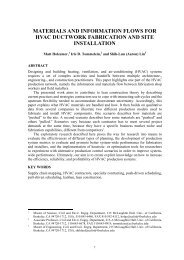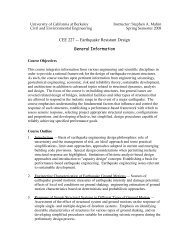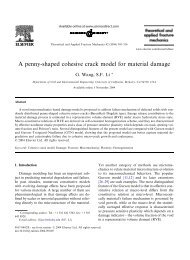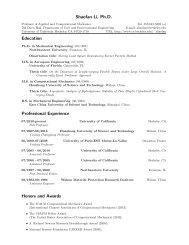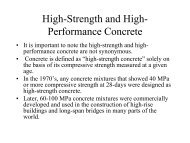Meshfree and particle methods and their applications - TAM ...
Meshfree and particle methods and their applications - TAM ...
Meshfree and particle methods and their applications - TAM ...
Create successful ePaper yourself
Turn your PDF publications into a flip-book with our unique Google optimized e-Paper software.
2 Li <strong>and</strong> Liu: <strong>Meshfree</strong> <strong>and</strong> <strong>particle</strong> <strong>methods</strong> <strong>and</strong> <strong>applications</strong> Appl Mech Rev vol 55, no 1, January 2002<br />
4 Accuracy can be controlled more easily, since in areas<br />
where more refinement is needed, nodes can be added<br />
quite easily h-adaptivity;<br />
5 The continuum meshfree <strong>methods</strong> can be used to model<br />
large deformations of thin shell structures, such as nanotubes;<br />
6 The method can incorporate an enrichment of fine scale<br />
solutions of features, such as discontinuities as a function<br />
of current stress states, into the coarse scale; <strong>and</strong><br />
7 <strong>Meshfree</strong> discretization can provide accurate representation<br />
of geometric object.<br />
In general, <strong>particle</strong> <strong>methods</strong> can be classified based on<br />
two different criteria: physical principles, or computational<br />
formulations. According to the physical modeling, they may<br />
be categorized into two classes: those based on deterministic<br />
models, <strong>and</strong> those based on probabilistic models. On the<br />
other h<strong>and</strong>, according to computational modelings, they may<br />
be categorized into two different types as well: those serving<br />
as approximations of the strong forms of partial differential<br />
equations PDEs, <strong>and</strong> those serving as approximations of<br />
the weak forms of PDEs. In this survey, the classification<br />
based on computational strategies is adopted.<br />
To approximate the strong form of a PDE using a <strong>particle</strong><br />
method, the partial differential equation is usually discretized<br />
by a specific collocation technique. Examples are smoothed<br />
<strong>particle</strong> hydrodynamics SPH 8–12, the vortex method<br />
13–18, the generalized finite difference method 19,20,<br />
<strong>and</strong> many others. It is worth mentioning that some <strong>particle</strong><br />
<strong>methods</strong>, such as SPH <strong>and</strong> vortex <strong>methods</strong>, were initially<br />
developed as probabilistic <strong>methods</strong> 10,14, <strong>and</strong> it turns out<br />
that both SPH <strong>and</strong> the vortex method are most frequently<br />
used as deterministic <strong>methods</strong> today. Nevertheless, the majority<br />
of <strong>particle</strong> <strong>methods</strong> in this category are based on<br />
probabilistic principles, or used as probabilistic simulation<br />
tools. There are three major <strong>methods</strong> in this category: 1<br />
molecular dynamics both quantum molecular dynamics<br />
21–26 <strong>and</strong> classical molecular dynamics 27–32; 2 direct<br />
simulation Monte Carlo DSMC, or Monte Carlo<br />
method based molecular dynamics, such as quantum Monte<br />
Carlo <strong>methods</strong> 33–41 It is noted that not all the Monte<br />
Carlo <strong>methods</strong> are meshfree <strong>methods</strong>, for instance, a probabilistic<br />
finite element method is a mesh-based method 42–<br />
44; <strong>and</strong> 3 the lattice gas automaton LGA, or lattice gas<br />
cellular automaton 45–49 <strong>and</strong> its later derivative, the Lattice<br />
Boltzmann Equation method LBE 50–54. It may be<br />
pointed out that the Lattice Boltzmann Equation method is<br />
not a meshfree method, <strong>and</strong> it requires a grid; this example<br />
shows that <strong>particle</strong> <strong>methods</strong> are not always meshfree.<br />
The second class of <strong>particle</strong> <strong>methods</strong> is used with various<br />
Galerkin weak formulations, which are called meshfree<br />
Galerkin <strong>methods</strong>. Examples in this class are Diffuse Element<br />
Method DEM 55–58, Element Free Galerkin<br />
Method EFGM 59–63, Reproducing Kernel Particle<br />
Method RKPM 64–72, h-p Cloud Method 73–76, Partition<br />
of Unity Method 77–79, Meshless Local Petrov-<br />
Galerkin Method MLPG 80–83, Free Mesh Method 84–<br />
88, <strong>and</strong> others.<br />
There are exceptions to this classification, because some<br />
<strong>particle</strong> <strong>methods</strong> can be used in both strong form collocation<br />
as well as weak form discretization. The <strong>particle</strong>-in-cell<br />
PIC method is such an exception. The strong form collocation<br />
PIC is often called the finite-volume <strong>particle</strong>-in-cell<br />
method 89–91, <strong>and</strong> the weak form PIC is often called the<br />
material point method 92, or simply <strong>particle</strong>-in-cell method<br />
93–95. RKPM also has two versions as well: a collocation<br />
version 96 <strong>and</strong> a Galerkin weak form version 66.<br />
In areas such as astrophysics, solid state physics, biophysics,<br />
biochemistry <strong>and</strong> biomedical research, one may encounter<br />
situations where the object under consideration is not a<br />
continuum, but a set of <strong>particle</strong>s. There is no need for discretization<br />
to begin with. A <strong>particle</strong> method is the natural<br />
choice in numerical simulations. Relevant examples are the<br />
simulation of formation of a star system, the nano-scale<br />
movement of millions of atoms in a non-equilibrium state,<br />
folding <strong>and</strong> unfolding of DNA, <strong>and</strong> dynamic interactions of<br />
various molecules, etc. In fact, the current trend is not only<br />
to use <strong>particle</strong> <strong>methods</strong> as discretization tools to solve continuum<br />
problems such as SPH, vortex method 14,15,97<br />
<strong>and</strong> meshfree Galerkin <strong>methods</strong>, but also to use <strong>particle</strong><br />
<strong>methods</strong> as a physical model statistical model, or atomistic<br />
model to simulate continuum behavior of physics. The latest<br />
examples are using the Lattice Boltzmann method to solve<br />
fluid mechanics problems, <strong>and</strong> using molecular dynamics to<br />
solve fracture mechanics problems in solid mechanics 98–<br />
103.<br />
This survey is organized as follows: The first part is a<br />
critical review of smoothed <strong>particle</strong> hydrodynamics SPH.<br />
The emphasis is placed on the recent development of corrective<br />
SPH. The second part is a summary of meshfree Galerkin<br />
<strong>methods</strong>, which includes DEM, EFGM, RKPM, hp-<br />
Cloud method, partition of unity method, MLPGM, <strong>and</strong><br />
meshfree nodal integration <strong>methods</strong>. The third part reviews<br />
recent <strong>applications</strong> of molecular dynamics in fracture mechanics<br />
as well as nanomechanics. The last part is a survey<br />
on some other meshfree/<strong>particle</strong> <strong>methods</strong>, such as vortex<br />
<strong>methods</strong>, the Lattice Boltzmann method, the natural element<br />
method, the <strong>particle</strong>-in-cell method, etc. The survey is concluded<br />
with the discussions of some emerging meshfree/<br />
<strong>particle</strong> <strong>methods</strong>.<br />
2 SMOOTHED PARTICLE HYDRODYNAMICS<br />
2.1 Overview<br />
Smoothed Particle Hydrodynamics is one of the earliest <strong>particle</strong><br />
<strong>methods</strong> in computational mechanics. Early contributions<br />
have been reviewed in several articles 8,12,104. In<br />
1977, Lucy 10 <strong>and</strong> Gingold <strong>and</strong> Monaghan 9 simultaneously<br />
formulated the so-called Smoothed Particle Hydrodynamics,<br />
which is known today as SPH. Both of them were<br />
interested in the astrophysical problems, such as the formation<br />
<strong>and</strong> evolution of proto-stars or galaxies. The collective<br />
movement of those <strong>particle</strong>s is similar to the movement of a<br />
liquid, or gas flow, <strong>and</strong> it may be modeled by the governing<br />
equations of classical Newtonian hydrodynamics. Today,<br />
SPH is being used in simulations of supernovas 105, col-


